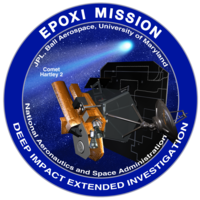EPOXI

The Deep Impact spacecraft at the JPL in July 2004.
|
|
| Mission type |
|
|---|---|
| Operator | NASA |
| COSPAR ID | 2005-001A |
| Website | epoxi |
| Mission duration | 8 years, 18 days |
| Spacecraft properties | |
| Spacecraft | Deep Impact |
| Manufacturer | JPL · Ball Aerospace · University of Maryland |
| Launch mass | 650 kg (1,430 lb) |
| Power | 620.0 W |
| Start of mission | |
| Entered service | July 21, 2005 (11 years, 6 months and 16 days ago) |
| End of mission | |
| Last contact | August 8, 2013 (3 years, 5 months and 29 days ago) |
| Flyby of Hartley 2 | |
| Closest approach | November 4, 2010 ~03:00 UTC (6 years, 3 months and 2 days ago) |
| Distance | 694 kilometres (431 mi) |
 Official insignia for the re-targeted DIXI mission to Hartley 2 |
|
|
|
EPOXI is a compilation of NASA Discovery program missions led by the University of Maryland and principal investigator Michael A'Hearn, with co-operation from the Jet Propulsion Laboratory and Ball Aerospace. EPOXI uses the Deep Impact spacecraft in a campaign consisting two missions: the Deep Impact Extended Investigation (DIXI) and Extrasolar Planet Observation and Characterization (EPOCh). DIXI aimed to send the Deep Impact spacecraft on a flyby of another comet, after its primary mission was completed in July 2005, while EPOCh saw the spacecraft's photographic instruments as a space observatory, studying extrasolar planets.
DIXI successfully sent the Deep Impact spacecraft on a flyby of comet Hartley 2 on November 4, 2010, revealing a "hyperactive, small and feisty" comet, after three gravity assists from Earth in December 2007, December 2008 and June 2010. The DIXI mission was not without problems, however; the spacecraft had initially been targeted for a December 5, 2008 flyby of comet Boethin, though, the comet could not be located, and was later declared a lost comet, prompting mission planners to reorganize a flyby of an alternative target, Hartley 2. After its flyby of Hartley 2, the spacecraft was also set to make a close flyby of the apollo asteroid (163249) 2002 GT in 2020. The mission was suspended altogether, however, after contact with the spacecraft was suddenly lost in August 2013 and attempts to re-establish contact in the month following had failed. Mission scientists theorized that a Y2K-like problem had plagued the spacecraft's software.
...
Wikipedia
